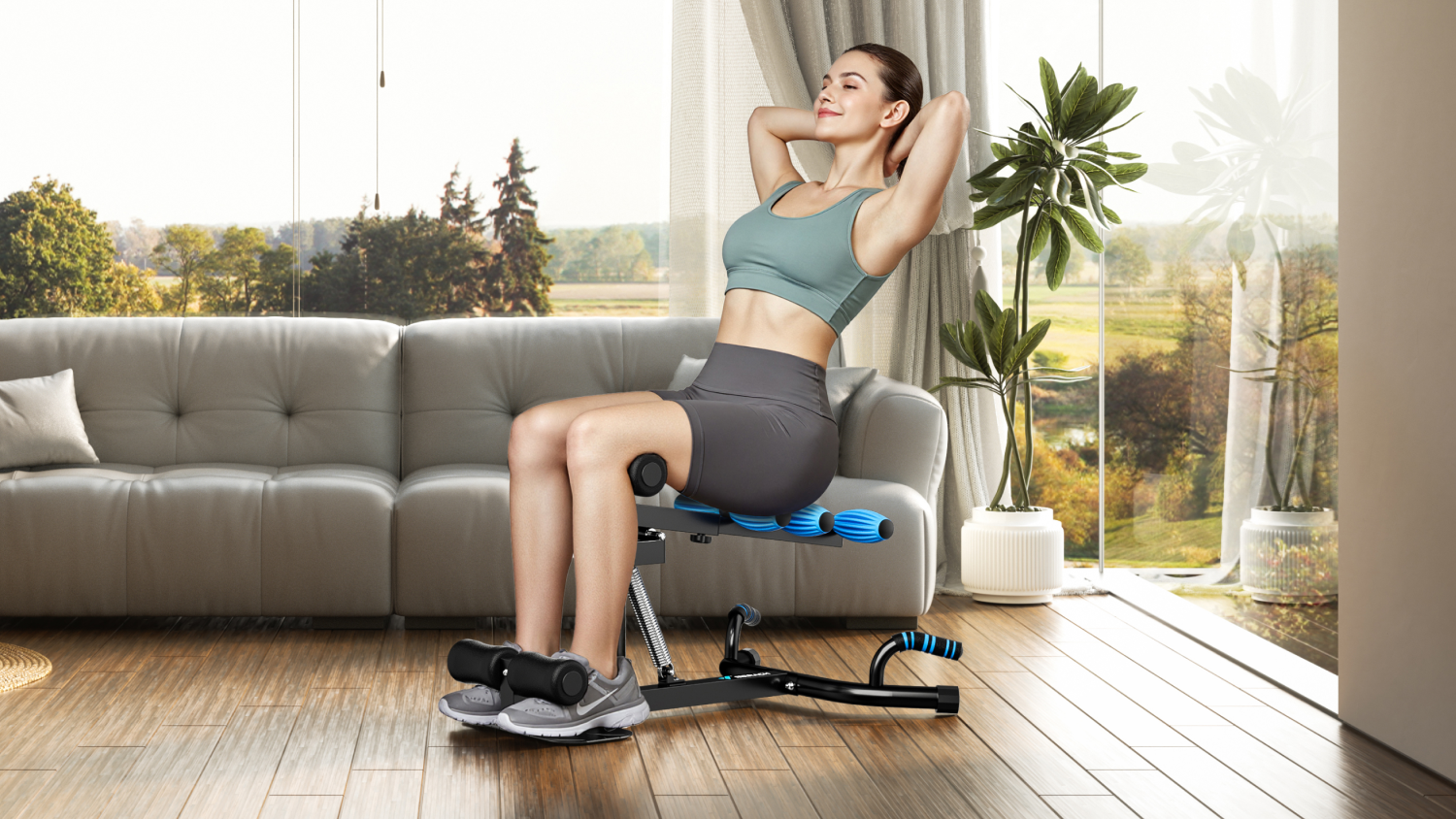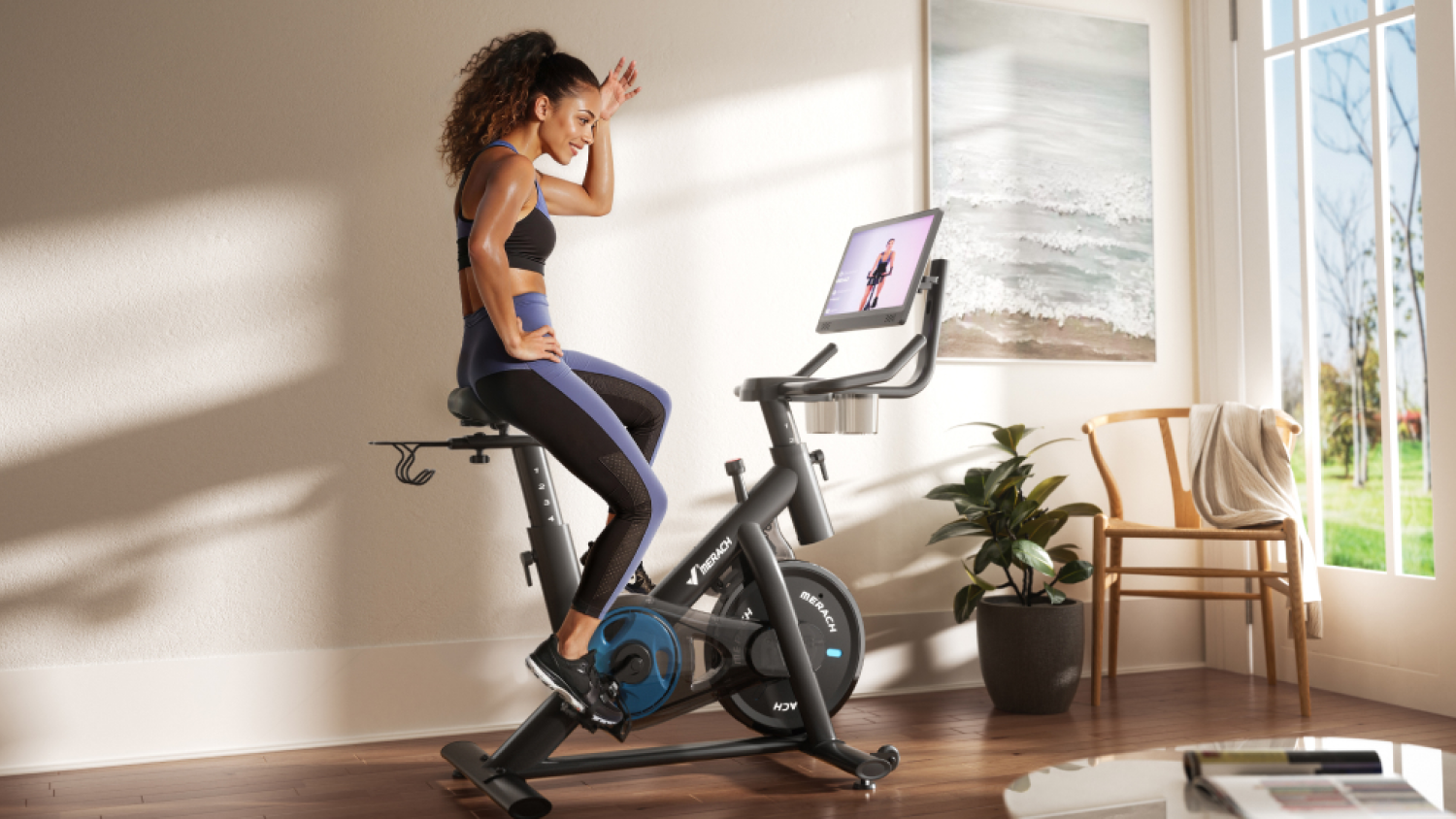Looking to build stronger glutes, legs, and core without heading to the gym? A deep squat machine might be exactly what you need. These compact machines are blowing up on social media for good reason - they help you nail proper squat form while reducing strain on your knees and back.
Whether you're a total beginner or just want to level up your home workouts, we're breaking down everything you need to know about how to use a deep squat machine, from setup to the best squat exercises at home you can do.
1. What Is a Deep Squat Machine?
A deep squat machine is a specialized piece of home fitness equipment designed to guide you into the perfect squat position while providing support and resistance. Unlike traditional squats, where you might struggle with balance or form, these machines use a structured design with adjustable resistance levels, padded supports, and foot placement options to help you squat safely and effectively. The machine typically features a backrest, shoulder pads, adjustable height settings, and resistance bands or springs that create tension as you squat. This setup allows you to focus entirely on engaging your glutes, quads, hamstrings, and core without worrying about tipping over or hurting your lower back.
Types of Squat Machines
| Squat Machine Type | How It Works | Key Benefits | Best For |
|---|---|---|---|
| Deep Squat Machine | Guides you into proper squat position with supported backrest | Reduced knee/back stress, high stability, easy to use at home | Beginners, home gym users |
| Hack Squat Machine | Places you at an angle with back and shoulder pads to handle heavier loads safely | Great for heavy lower-body training and building strength | Intermediate to advanced lifters |
| Belt Squat Machine | Loads weight through a belt around your waist to remove spinal compression | Intense leg training without loading the spine | Lifters with back issues or heavy training needs |
| Pendulum Squat Machine | Uses a swinging arm with a natural arc that encourages deeper, joint-friendly squats | Joint-safe mechanics, deeper range of squat motion, strong glute activation | Users seeking deeper squats and better glute engagement |
| Smith Machine | Features a barbell fixed to vertical rails to control the up-and-down path | Extra stability, safer for beginners learning the movement | Beginners, safety-focused users |
| Sissy Squat Machine | Uses a backward-leaning position to isolate the quadriceps | Strong quad isolation and knee-extension strength | Users targeting the front thighs |
For home use, compact deep squat machines offer the best balance of effectiveness, safety, and space efficiency. If you want a machine that supports proper form, protects your knees and back, and fits easily into small home gyms, the Merach Deep Squat Machine is one of the most practical and versatile options to consider.
Who Should Use It?
Deep squat machines are generally safe for most people. If you have existing knee problems, back injuries, or other joint issues, check with your doctor or physical therapist before starting. While the machine reduces strain compared to free-weight squats, it still loads these areas. Pregnant women should also consult their healthcare provider before using squat machines.
The machine's supportive design makes it an excellent option for people who struggle with traditional squats due to balance issues or limited mobility. Beginners especially benefit from the guided motion that helps them learn proper squat mechanics without the complexity of free weights. The adjustable resistance means you can start super light and build up gradually.
2. Benefits of Using a Deep Squat Machine
Before diving deeper into the specific benefits, it's helpful to understand which muscles deep squats actually work to improve your overall results.
Muscles Worked During Deep Squats
Deep squats primarily target:
- Quadriceps - located at the front of your thighs; responsible for knee extension
- Gluteus maximus - the main muscle of your butt; it works harder the deeper you squat, making deep squats great for glute growth
- Hamstrings - located at the back of your thighs; they help control the lowering phase and support hip movement
- Calves - assist in stability and support during the squat
- Core muscles - including the abs, obliques, and lower back, which stabilize your body and maintain proper posture
- Inner thighs - activate more during wide-stance squats
- Upper body - if your deep squat machine includes push-up handles, exercises like push-up variations can also target your chest, shoulders, and triceps
This combination of lower-body, core, and even upper-body involvement makes deep squats one of the most effective full-body movements for strength, stability, and calorie burning.

Deep Squat Machines Benefits
Deep squat machines offer several advantages that make them stand out from regular bodyweight squats or free-weight variations:
- Help you maintain proper form: the guided structure keeps your back aligned and prevents common mistakes like knees caving inward or leaning too far forward, making it especially beginner-friendly
- Reduce joint stress: the machine provides built-in support that takes pressure off your knees and lower back, making it safer for people with joint concerns or those recovering from injuries
- Adjustable resistance: you can start light and increase the load gradually as you get stronger, making it suitable for all fitness levels
- Enable deeper squats: the machine's design allows a greater range of motion than many people can achieve on their own, resulting in better glute and quad activation
- Support multi-purpose training: many deep squat machines can be used for more than squats, including push-ups, core exercises, and even upper-body movements
- Offer more value for home gyms: one compact machine can replace multiple pieces of equipment, giving you versatile training options in limited space
Overall, a deep squat machine gives you safer mechanics, better muscle activation, and more training versatility than traditional squat variations. It's one of the most efficient ways to build lower-body strength at home without sacrificing space or risking poor form.
3. How to Set Up Your Deep Squat Machine?
Before you start your first workout, proper setup is key to getting the most out of your machine. Most deep squat machines come partially assembled and take about 10 minutes to put together. You'll usually find the frame pre-assembled with just a few parts to attach - the foot hooks, backrest pad, and resistance bands or springs. Make sure all bolts are tightened securely before use.
Once assembled, place the machine on a flat, stable surface with enough room around it for safe movement. Many machines come with anti-slip foot covers that protect your floor and keep the equipment from sliding during use.
Next, adjust the machine to fit your body. The foot hooks should be set at a height where your feet rest comfortably when you're in the starting position. Most machines offer 2-3 height settings. The backrest angle can usually be adjusted to 30°, 60°, or 90°, depending on your preference and the exercise you're doing. Start with a moderate angle (around 60°) if you're new to the machine.
Finally, set your resistance level. Begin with the lowest resistance setting to get used to the movement, then gradually increase as your strength improves.

4. How to Use a Deep Squat Machine Properly?
Using a deep squat machine correctly can make a huge difference in how effective and safe your workouts are. In this section, we'll help you to use a deep squat machine correctly. We'll also cover key safety tips and how often you should train, so you can get the most out of every session and see real results.
Use of a Squat Machine
Nailing proper form on the deep squat machine is straightforward once you get the hang of it. Follow these steps for a safe and effective squat:
- Position yourself correctly: Sit comfortably on the machine with your feet on the footrests and your back against the padded support. Feet should be hip to shoulder-width apart with toes slightly outward. Hold the handles near your sides for stability.
- Engage your core: Pull your belly button toward your spine to protect your lower back throughout the movement.
- Perform the squat: Lower yourself slowly by bending at the hips and knees simultaneously. Keep your chest up and maintain contact with the backrest. Lower until your hips drop below your knees, or as deep as your mobility allows.
- Controlled movement: Pause for a second at the bottom, then push through your heels to rise back up. Focus on driving your hips upward and squeezing your glutes at the top. Avoid bouncing or jerky motions.
- Breathing technique: Inhale as you lower down and exhale as you push back up. Proper breathing enhances core stability and provides more power during the lift.
Safety Precautions
Even with a squat assist trainer, safety is essential. Keep these points in mind:
- Machine stability: Ensure the machine is on a flat, stable surface and all adjustment pins and bolts are secure before each use
- Footwear: Wear proper athletic shoes with good traction; avoid slippery socks or bare feet
- Pain awareness: Stop immediately if you feel sharp pain that differs from normal muscle burn. Listen to your body and avoid pushing through discomfort
How Often to Use a Deep Squat Machine?
For beginners, starting with 2-3 sessions per week is the sweet spot. This frequency allows you to build strength and technique while giving your muscles enough time to recover between workouts. Each session should include 3-5 sets of your chosen squat variation with 8-12 reps per set.
As you get more experienced, you can increase frequency to 3-4 times per week, but make sure you're varying the intensity - not every workout needs to be maximum effort. Consider following a pattern like heavy day, light day, medium day, rest, repeat. This prevents overtraining and keeps your muscles challenged in different ways.
On your rest days, you might do upper body cardio or active recovery like walking or yoga. You'll see better results from regular, moderate workouts than from sporadic intense sessions. If you're constantly sore or your performance is declining, you might need more recovery time. On the flip side, if you're breezing through your workouts without breaking a sweat, it's time to increase the challenge.
5. Top 5 Squat Workouts for Beginners
Ready to put your deep squat machine to work? These beginner-friendly workouts help you build strength, improve technique, and increase lower-body confidence. Each mini-workout includes reps, sets, rest time, and key cues.

1) Basic Deep Squats
This is the best starting point for absolute beginners. Set your machine to the lowest resistance and focus on learning the fundamental movement. This workout helps you master proper form while improving balance, stability, and depth without overwhelming your joints. It also builds the foundation for more advanced squat variations.
How to do it:
- Perform 3 sets of 8-10 reps
- Rest 60 seconds between sets
- Keep your chest up, core tight, and push through your heels
2) Pause Squats
Pause squats teach you control in the most challenging part of the movement - the bottom position. Stopping at the bottom increases time under tension, builds explosive strength, and improves mobility. It forces your muscles to stay engaged without relying on momentum.
How to do it:
- Add a 3-5 second pause at the bottom of each rep
- Perform 3 sets of 6-8 reps
- Maintain tension in your core and glutes during the pause
3) Tempo Squats
Tempo training increases muscle engagement by slowing down key parts of the squat. This variation is excellent for muscle growth because longer tension improves hypertrophy. It also teaches you to control the entire range of motion, making your form more stable and consistent.
How to do it:
- Lower yourself for 3-4 seconds
- Pause briefly for 1 second at the bottom
- Rise back up with a controlled but powerful movement
- Perform 3 sets of 8 reps
4) Wide Stance Squats
Changing your stance alters which muscles take on the most work. The wider stance targets the inner thighs (adductors) and glutes more effectively. It's also a great option for learners who struggle with ankle mobility, as it allows easier depth.
How to do it:
- Place your feet wider than shoulder-width
- Point your toes outward to follow your knee alignment
- Perform 3 sets of 10-12 reps
5) Progressive Resistance Circuit
This workout helps you build strength and endurance by gradually increasing resistance within a single set. This pyramid-style approach challenges multiple muscle fibers, boosts overall leg strength, and improves stamina. It's also an excellent way to track your progress over time as you increase loads.
How to do it:
- Start at low resistance for 10 reps
- Increase to medium resistance for 8 reps
- Increase to high resistance for 6 reps
- Rest 2 minutes
- Repeat 2-3 rounds
By consistently following these beginner-friendly workouts, you'll build a solid foundation of strength, improve your squat form, and activate key muscle groups in your legs, glutes, and core. Start with the lower resistance settings to master each movement, then gradually progress in intensity as your confidence and strength grow. Remember, quality and control are more important than speed or weight.
6. Common Mistakes to Avoid
Even with the machine's guidance, some mistakes can sneak in and limit your results or cause discomfort. Here are the key errors to watch out for:
Knees Caving Inward
One of the most common mistakes is letting your knees collapse inward during the squat. Keep your knees aligned with your toes throughout the movement. Think about gently pushing them slightly outward. This ensures proper tracking of your joints and reduces the risk of knee strain or injury.
Not Squat Deep Enough
Failing to go deep diminishes the benefits of using a deep squat machine. The machine is designed to help you achieve a full range of motion, so don't settle for half reps. Lower your hips below your knees if your mobility allows. Going deeper engages your glutes, quads, and hamstrings more effectively, maximizing strength and muscle growth.
Rounded Lower Back
Rounding your lower back places unnecessary stress on your spine and reduces the efficiency of the exercise. Keep your spine neutral by engaging your core and maintaining contact with the backrest throughout the movement. A strong, stable core protects your lower back and improves overall squat mechanics.
Bounce Out Of The Bottom Position
Some people try to "bounce" out of the lowest position using momentum rather than muscle control. This reduces muscle activation and can strain your joints. Focus on controlled movements, using your leg and glute muscles to rise smoothly. Controlled reps also improve balance and technique over time.
Rush Through Reps
Speed is not the goal. Rushing through your reps compromises form and reduces the exercise's effectiveness. Each repetition should be deliberate and controlled - take about 2-3 seconds to lower and 1-2 seconds to rise. Slower, mindful movements ensure proper muscle engagement and better long-term results.
By avoiding these common mistakes, you can maximize the effectiveness of your deep squat machine, reduce the risk of injury, and see faster progress in strength, stability, and muscle development. Focus on form, control, and gradual progression to get the most out of every squat session.
7. Tips for Maximizing Your Deep Squat Machine
To really maximize your results, keep these tips in mind.
First, always warm up before you start squatting. Spend 5-10 minutes doing dynamic stretches like leg swings, hip circles, and bodyweight squats to get your muscles and joints ready. This increases blood flow and reduces injury risk.
Second, focus on progressive overload. Once you can comfortably complete 3 sets of 12 reps at your current resistance level, it's time to bump up the difficulty. This constant challenge is what drives strength gains and muscle growth.
Third, vary your foot placement. Different stances target muscles slightly differently - a narrower stance emphasizes the quads, while a wider stance hits the glutes and inner thighs harder. Mix it up to develop balanced leg strength.
Fourth, don't skip rest days. Your muscles grow during recovery, not during the workout itself. Aim for 2-3 squat sessions per week with at least one rest day in between.
Finally, track your progress. Keep a simple log of your sets, reps, and resistance levels. Seeing your numbers improve over time is super motivating and helps you stay consistent.
8. FAQs about Deep Squat Machines
As you consider adding a deep squat machine to your home gym, several questions might naturally come to mind. We've compiled the most common ones below to provide clear, straightforward answers and help you make an informed decision.
Q1: Can you build muscle with a deep squat machine?
Absolutely! Deep squat machines provide progressive resistance that challenges your muscles, leading to strength gains and muscle growth in your glutes, quads, hamstrings, and core. The key is to gradually increase resistance over time and maintain proper nutrition to support muscle development.
Q2: Is a deep squat machine good for beginners?
Yes, deep squat machines are actually ideal for beginners because they guide you into proper form and provide stability that free-weight squats don't offer. The adjustable resistance lets you start light and build up gradually as you gain strength and confidence.
Q3: How deep should you squat on a squat machine?
Ideally, you should lower yourself until your hips drop below your knees for maximum glute and quad activation. However, only go as deep as feels comfortable for your current mobility level. Over time, your range of motion will improve.
Q4: Can a squat machine replace gym squats?
While deep squat machines offer many benefits, they work best when combined with other exercises. They're fantastic for home workouts and can definitely deliver results, but free-weight squats engage more stabilizer muscles. Using both gives you the best of both worlds.
Q5: How long does it take to see results from using a squat machine?
With consistent use (2-3 times per week) and proper nutrition, most people notice improved strength within 2-3 weeks and visible muscle development within 6-8 weeks. Results vary based on your starting point, effort level, and overall lifestyle.
9. Conclusion
Using a squat machine correctly can not only effectively improve your training results but also ensure your safety. The basic techniques and five training plans introduced in this guide will help you progress step by step from a beginner, fully leveraging the training value of the squat machine.
If you are looking for a squat machine suitable for home use, try the Merach Deep Squat Machine. It features an ergonomic design with thickened padding and adjustable components, perfectly supporting all the training movements introduced in this article. Whether it's basic squats or high-intensity interval training, it provides stable support and a comfortable training experience.
Ready to start your home fitness journey? Start your squat training journey now! Through consistent practice, you will quickly see improvements in strength and physique.


































Leave a comment
All comments are moderated before being published.
This site is protected by hCaptcha and the hCaptcha Privacy Policy and Terms of Service apply.